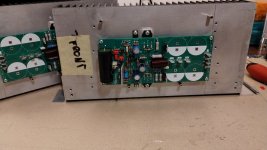Congratulations, it looks promising, but a detail worries me: is it a 0.56 ohm I see in the Zobel? It should be 5.6 ohm. I don't think it will cause problems, but it is preferable to stick with the original value
Thanks!
The resistor in Zobel is definitely 5R6. I usually double-check resistors before soldering 🙂
F
The resistor in Zobel is definitely 5R6. I usually double-check resistors before soldering 🙂
F
Lovely Design, good for a duall mono amp construction, what is the size of the board.
OK, but then the color code is incorrect: the multiplier band should be gold, not silver for a three-band indication. That said, I have seen weirder things, like the cathode band of diodes on the wrong side...Thanks!
The resistor in Zobel is definitely 5R6. I usually double-check resistors before soldering 🙂
F
Just got a set of OscarGolf/Stallion Circlo PCBs and have started populating them. Getting close now that I'm waiting on a couple of capacitors and some heatsink, so a quick question, how large should I size my xformer for a stereo pair. Just wondering if my single 18-0-18 100VA that I have available will suit my needs, or should I order a second to match, and dual mono my power supply as well?
Last edited:
It is comfortable if you have 8ohm speakers, but for 4ohm, it is a bit marginal: it is the dimensioning used for "budget" amplifiers. That said, for a relaxed domestic use, it is still acceptable
Hi,
Quick Q: It seems that my rails will be +/-34V (slightly lower than the anticipated +/-35V). Should I adjust D8+D9 for total 32V drop?
Thanks,
F
Quick Q: It seems that my rails will be +/-34V (slightly lower than the anticipated +/-35V). Should I adjust D8+D9 for total 32V drop?
Thanks,
F
@oscargolf - have you tried or made any progress on a single supply Circlophone? Has anybody built a single rail C yet? I would certainly be interested in a set of boards or the gerber files if possible.Hello to all,
still looking for the contribution that you can build or operate the Circlophone with a single power supply.
As far as I know, the rail voltage was +50V.
Elvee had once provided a circuit diagram.
Does anyone know advice?
Thanks
I have: I have upgraded one of my old lab amp with a single supply C. No PCB though, it was built on a perfboardHas anybody built a single rail C yet?
Any noticeable difference in sound quality Elvee?
I've been reading both here and in the main thread. Would really like to try a (normal/original) C, but still not clear on what PSU to use. Using smps supplies is so much simpler and a much cheaper option in our part of the world. I've even used two smps supplies in series for a dual rail Class A amp before.
Maybe I must clarify - not sure if the C benefits more from a linear supply, or does it have a constant current draw like a Class A, which benefits from cap multiplier supplies.
I've been reading both here and in the main thread. Would really like to try a (normal/original) C, but still not clear on what PSU to use. Using smps supplies is so much simpler and a much cheaper option in our part of the world. I've even used two smps supplies in series for a dual rail Class A amp before.
Maybe I must clarify - not sure if the C benefits more from a linear supply, or does it have a constant current draw like a Class A, which benefits from cap multiplier supplies.
The core of the C remains the same, and if you use a generous enough output cap, there should be no difference.
The C does not require a linear supply: it has a high enough PSRR, but SMPS's have other issues than just differential noise/ripple. They also introduce common mode perturbations appearing between the general GND or PE, or the ambient "aether", resulting in difficult to solve issues, mainly buzzing sounds, various noises or hum.
If you use a class II linear supply, you don't have to worry about ground loops, etc.
That said, it is perfectly possible to integrate a class I SMPS and have a perfectly quiet noise floor, but it is more demanding, and each time you connect an additional source, you might find yourself in trouble
The C does not require a linear supply: it has a high enough PSRR, but SMPS's have other issues than just differential noise/ripple. They also introduce common mode perturbations appearing between the general GND or PE, or the ambient "aether", resulting in difficult to solve issues, mainly buzzing sounds, various noises or hum.
If you use a class II linear supply, you don't have to worry about ground loops, etc.
That said, it is perfectly possible to integrate a class I SMPS and have a perfectly quiet noise floor, but it is more demanding, and each time you connect an additional source, you might find yourself in trouble
I finally found some time to fire up the amp. It is alive!
DC offset 3mV, rail current draw 200mA. Both channels identical.
DC offset 3mV, rail current draw 200mA. Both channels identical.
Playing music for the first time. One channel at the time. No surprises.
Interestingly, when I mute the source and stick my ear into the speaker I can hear nothing. This amp is really silent 🙂
Next steps: assembly the big caps, install the second transformer and listen in stereo.

Interestingly, when I mute the source and stick my ear into the speaker I can hear nothing. This amp is really silent 🙂
Next steps: assembly the big caps, install the second transformer and listen in stereo.
- Home
- Amplifiers
- Solid State
- Building Elvee's Circlophone: Documentation, Parts, Accessories, & beginner friendly
